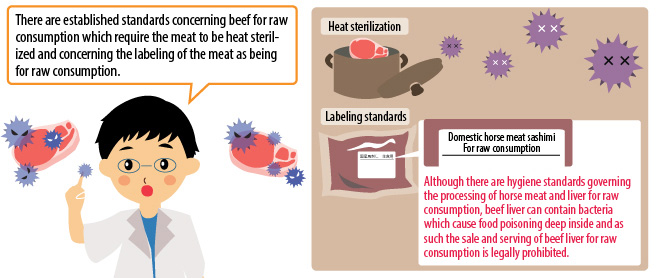Tokyo Food Safety Information Center » Tokyo Metropolitan Government food safety FAQ » Are there any regulations concerning meat provided for raw consumption?
Are there any regulations concerning meat provided for raw consumption?

Are there any regulations concerning meat provided for raw consumption?
- Is it safe to buy beef from a store and eat it raw?
- Is there any way to eat beef liver raw without breaking the law?

There are established standards concerning beef for raw consumption which require the meat to be heated to kill bacteria which cause food poisoning and concerning the labeling of the meat as being for raw consumption.
Because beef liver can contain bacteria which cause food poisoning deep inside, the sale and serving of beef liver for raw consumption is legally prohibited.
Pork meat, liver, and other organs can result in infection by the hepatitis E virus when eaten raw, as well as food poisoning by bacteria or even more severe food poisoning by parasites. Accordingly, the sale and serving of pork for raw consumption has also been banned by law.
There are also hygiene standards concerning the preparation of horse meat and liver for raw consumption.
There are no standards concerning the raw consumption of chicken. However, chicken should always be cooked before consumption.
Eating raw meat carries the risk of getting food poisoning. Raw meat, even that specially prepared for being eaten raw, should not be served to children, senior citizens, and persons with weakened resistance to food poisoning.


There are legally required preparation and labeling standards concerning beef for raw consumption (excluding organs).
The preparation standards require that the surface of beef (in block form) at least 1 centimeter deep be heated to 60° C for at least two minutes to kill bacteria, after which this cooked portion is removed. There are also standards concerning the content of the meat which require it to test negative for Enterobacteriaceae bacteria (such as Enterohemorrhagic E. coli and salmonella).
The labeling standards require that the meat be labeled as for being for raw consumption as well as the name of the slaughterhouse where it was prepared, the prefecture it came from, and the name and address of the facility where it was processed for raw consumption.
As it is impossible to completely eliminate bacteria which cause food poisoning such as Enterohemorrhagic E. coli even in meat prepared for raw consumption, the risk of food poisoning is not zero.
Accordingly, meat for raw consumption must be labelled as 1) carrying a risk of food poisoning and that 2) it should not be served to children, senior citizens, and others with weakened resistance to food poisoning. Such information must also be displayed at restaurants that serve raw beef.
As regards beef liver, Enterohemorrhagic E. coli O157 has been detected not only on the surface but also inside beef liver. Accordingly, the sale and serving of beef liver for raw consumption has been banned per the Food Sanitation Act. Stores and restaurants which sell and serve raw liver are required by law to tell consumers that the liver must be cooked thoroughly all the way to its center. Even in your own home, be sure to cook beef liver thoroughly and completely before eating it.
A variety of methods have been investigated for preventing food poisoning from eating raw beef liver. Currently, however, it is not possible to kill bacteria such as Enterohemorrhagic E. coli which can be found deep inside beef liver and, accordingly, the sale and serving of beef liver for raw consumption is legally prohibited. Future research may someday find a way to make eating raw beef liver safe, eliminating the need for this regulation.
Pork meat, liver, and other organs can result in infection by the hepatitis E virus when eaten raw, as well as food poisoning by bacteria or even more severe food poisoning by parasites. Accordingly, the sale and serving of pork for raw consumption has also been banned by law.
There are hygiene standards for horse meat and liver which require meat and liver for raw consumption to be properly prepared and to be labeled as being for raw consumption.
There are no standards governing the raw consumption of chicken, but note that bacteria which cause food poisoning have been detected in commercially available chicken, including salmonella and Campylobacter. Eating chicken raw or which has not been sufficiently cooked increases your risk of getting food poisoning. Children, senior citizens, and those with weakened resistance to food poisoning should not eat raw or insufficiently cooked chicken.